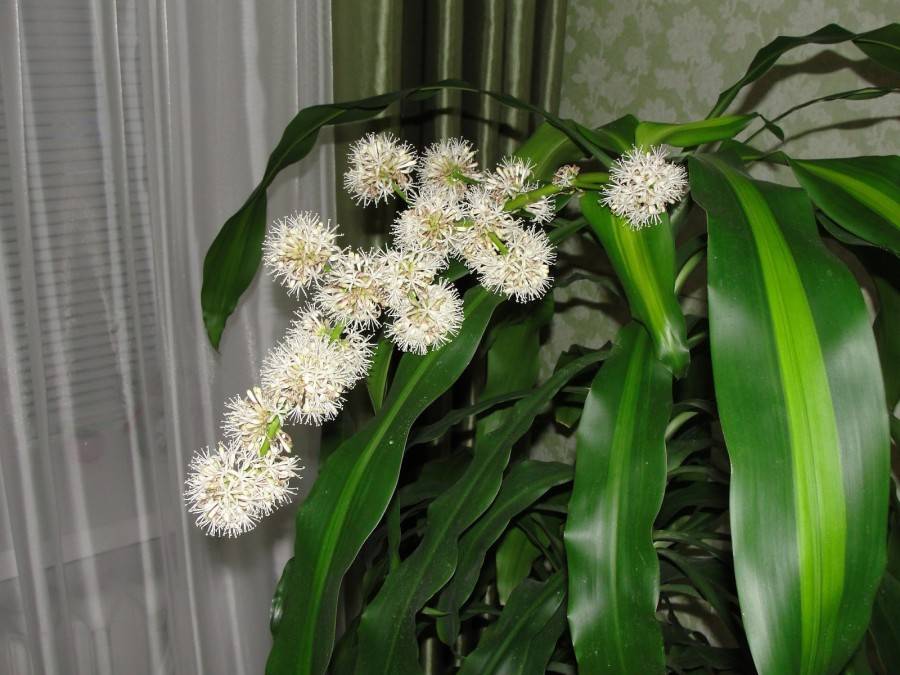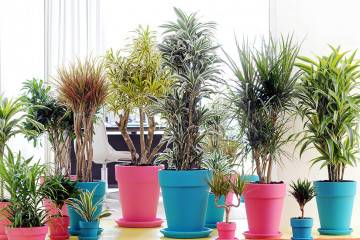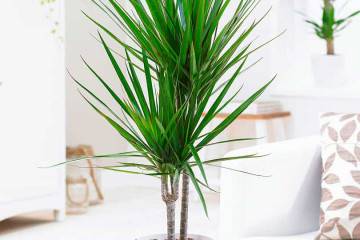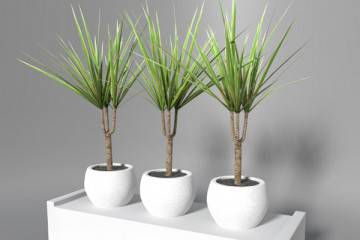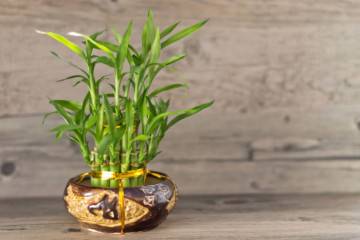Dracaena - home care
Content:
Dracaena has several beautiful names. It is called a room palm, a dragon tree, a dragon's tail. This plant is very popular among home growers because it looks great in the interior.
What does dracaena look like, which family it belongs to
Dracaena is an indoor exotic shrub, whose homeland is the hot tropics. The main places of growth are Africa, Asia, South America. Belongs to the asparagus family.
The history of the appearance of the most popular home dracaena, Bordered or Marginata, is associated with Madagascar, it is there that it grows.
The shrub has an exotic, attractive look. Outwardly, it looks like a mini palm tree. It has a straight stem, on which is a rosette with a bunch of thin leaves. Over time, the stem becomes strong, overgrown with woody tissue.
The plant can be grown up to 3 meters in height. The leaves of the house palm are elongated, and the surface is either striped or bright green in color. The size of the sheet is from 15 to 70 cm in length.
Home dracaena, the care of which is not difficult even for novice gardeners, has several popular varieties. Common varieties for home cultivation are:
- Bordered, or Marginata.
- Dracaena Unbent, or Reflex.
- Dracaena Godsef.
- Dracaena Fragrant.
- Dracaena Deremskaya.
The plant is recommended to be placed in the bedroom if there is a sick person there. It produces high-quality air purification, removes harmful chemicals from the air. The color is useful for treating skin diseases, bone injuries. Considering that the plant has good energy, it is beneficial for people suffering from depression.
Features of caring for dracaena at home
Dracaena tolerates home care easily. Providing favorable conditions for the flower is simple. It is enough to comply with the conditions under which the plant will have a healthy appearance. A number of factors that are important for the proper growth of dracaena include temperature, lighting, irrigation regime, soil fertilization, and other constituent factors.
Temperature
It should be close to the moderate temperature regime of subtropical latitudes. In summer it is 22-24 degrees. In the hot season, the flower is kept on the balcony, veranda.
Lighting
Dracaena likes to be in a light shade. She feels great under diffused light. She can get burns from direct sunlight. Varieties with variegated leaves require more light than varieties with green leaves. In summer, the flower is placed on the south side of the room, about one and a half meters from the window.
Air humidity
A humid indoor climate helps to maintain a beautiful appearance, but constant moisture is not necessary. The shrub is often kept in offices. It also withstands dry air well.
Spraying
In extreme heat, color is sprayed. The dust accumulated on the foliage, the trunk is periodically removed with a cool shower from a spray bottle.
Watering
In summer, the flower is watered once every three to four days. In winter, it is enough to water the plant once a week. Once a month, the plant is given abundant watering. At the same time, it is convenient to put a large plant in a wide container. A small species is kept in water for a couple of minutes at a room temperature of 20 degrees.
Some varieties require frequent or daily watering.
Priming
The land for the plant is peaty, sod-leafy. A lot of drainage is required, because a significant part of the root system is located close to the surface.
Top dressing
The soil is fertilized with complex fertilizers. Top dressing of "palms" is carried out in 15-20 days, starting in mid-March and ending in early September. During this period, the dracaena plant is actively growing.
Features of care in winter, dormant period
For a flower to develop well, it is important to know how to grow a particular species, how to care for it at different times. During warm and cold periods. Particular attention should be paid to the flower in winter, when there is a lack of heat, less often sunlight comes in. A few simple conditions must be met:
- in winter, dracaena is exposed to the south, southeast side of the window;
- the room temperature can be brought up to 14-16 degrees. A lower temperature threshold is contraindicated;
- watering in winter is carried out once a week;
- the lack of light is compensated by the use of special lighting lamps.
When and how it blooms
More than 140 varieties of dracaena are known. With green, striped shapes. Having wide, narrow leaves. Shrub and tree species. At home, they prefer to grow the following varieties:
- Dracaena Bordered (Marginata). An unpretentious, ornamental plant with a strong trunk. Reaches over three meters in height. With narrow leaves. The width of the leaf is one to two cm, the length is 45-60 cm. The color is green, sometimes the leaf surface is decorated with red-purple stripes. Tolerates dryness well;
- Dracaena Fragrant. It has a straight barrel (over 2 m). Leaves with silvery or yellow stripes hang from the rosette. When it begins to bloom, it emits a pleasant aroma emanating from the fragrant snow-white flowers. Unpretentiousness allows the plant to withstand insufficient watering, poor light and low winter temperatures of 10-12 degrees;
- Dracaena Deremskaya. A plant with dark green leaves, decorated with two white stripes along the length. The leaves can be bent at the ends;
- Dracaena Sander. Has a graceful look. Slim trunk up to 110 cm in height. Leaves with a grayish-green tint. Two yellow stripes run along the surface of the sheet. The leafy edges are slightly twisted. Sandera is used to warm, humid conditions;
- Dracaena Reflex (bent). Possesses a lush shiny crown. The foliage is elongated, hanging in different directions. The surface of the leaves has a golden edge, bright green colors;
- Dracaena Godsef (Surculosis). The species is very different from other varieties. It has a bushy shape, oval-pointed leaves of a dark green hue. Leaves have creamy white or golden spots.
Caring for different varieties may have some differences, but more often the conditions are similar to those listed above.
Pruning
At home, the dracaena flower lives for 15-20 years. This is with good care. Pruning is essential to achieve healthy development. The foliage gradually thinns, the trunk becomes bare. The life span of the leaves is about a year. Then they dry out and begin to fall off.Competent pruning will contribute to the appearance of lateral shoots, the restoration of the "splendor" of the foliage,
Pruning is performed with active growth, with the onset of the spring-summer period. The following points are taken into account:
- broken stems are pruned just below the fracture line;
- pruning height is planned along the upper part of the crown, where the leaves are in the light;
- pruning tools are disinfected;
- pruning of dracaena is performed in a completely healthy plant, an adult species, not infected with pests;
- the trimmed stump is smeared with garden varnish or sprinkled with charcoal (it can be pharmacy, activated). From above it should be covered with a glass cover and wait for new shoots.
How dracaena reproduces
Reproduction is carried out at any time of the year. Spring and summer are considered the best. Reproduction is done in several ways.
Seeds
They are on sale. You can buy any kind. Fresh seeds are planted in the soil. They are preliminarily cleaned of fruit residues and kept for 10-15 minutes in a growth stimulant solution. Dry seeds should be planted in a wet sandy-peat, disinfected mixture in small molds. Sprinkle soil on top, apply a film. The seed germinates successfully at a temperature of 25 degrees Celsius.
The germination process is not fast. Seedlings appear in 25-30 days. After that, they are transplanted into separate pots.
Cuttings
Dracaena reproduces by apical and stem cuttings. In the first case, the top of the adult shoot with a part of the stem is carefully cut off with a knife, 15–18 cm away from the last leaf. The stem is cleaned of leaf debris and dried for 2-3 hours.
To root a cutting at home, you can:
- use ordinary water with the addition of a root-forming stimulant, charcoal;
- add crushed coal, sand, peat to the soil mixture;
- use vermiculite or perlite, steamed soil.
Cuttings from the stem are taken in the case of cutting off long stems. Cut a healthy stem into 10-15 cm fragments. Root the cuttings by analogy with the first method. Place the pieces vertically and horizontally in the substrate. Deepening in wet soil is performed a couple of centimeters.
Air layering
This method of propagation is used when it is not possible to propagate by cuttings. This method is recommended for experienced gardeners.
The step-by-step instructions include:
- the device of a transverse incision on the stem;
- inserting a match into the slot to prevent overgrowth;
- covering the trunk with sphagnum moss around the incision;
- covering with a film;
- irrigation of moss with water.
After 1-2 months, roots appear. The sprout is cut off, and the plant is planted in a small container.
Transfer
Dracaena transplant is performed in the spring. It is important here to determine which pot is needed for the dracaena, so that it is comfortable for her. A container is selected 2-3.5 cm larger in diameter, in which drainage holes are arranged to allow excess moisture to pass through.
Sod-leaf soil mixed with compost-peat soil is laid in a new container. Pre-arrange drainage from fine expanded clay, sand.
After transplanting, the internal voids are filled with soil. Next, tamping and watering are performed. The plant is watered frequently during the first two weeks. Also, periodically, top dressing is done with preparations for root growth.
Possible growing problems and diseases
Flower problems can begin if you do not know how to care for dracaena. The plant may have such ailments:
- mass dropping of foliage occurs if the correct watering is not observed, due to the occurrence of an infectious disease. In addition to improper watering, the cause of the discharge can be frost in the soil if the flower is on the cold, blown side;
- pallor at the leaves occurs if the soil dries up. This happens again due to a lack of moisture;
- when dry tips form on dracaena leaves, the cause may be salts accumulated in the soil, lack of micronutrients in the soil.
Falling of the lower leaves may be infrequent. This is a natural process with healthy growth. It is worth worrying about a prolonged fall. The reasons are the same as indicated above. Yellowness on the surface of the leaves, dark spots become warning features.
The appearance of pests is also a natural result of improper care. Small insects can also threaten houseplants in more favorable conditions. The most common of them are considered:
- thyroid gland;
- spider mite;
- thrips;
- mealybugs.
Knowledge of the rules of care will help prevent the appearance of pests. Pest control drugs are sold in specialized stores.
In search of information on how to care for dracaena in a pot at home, gardeners will learn that, in addition to pests and diseases, viruses and bacterial infections can create problems. For example, bacteriosis, phylostictosis. They lead to rotting of roots and leaves. They fight this phenomenon by spraying with fungicides.
Signs and superstitions
Dracaena is known to many gardeners as a flower that can bring happiness to the house, as the guardian of peace in the family. It is customary for the inhabitants of the Celestial Empire to give a dracaena for a wedding.
If you believe superstitions and omens, any dracaena palm tree is a talisman capable of attracting love, wealth, good luck.
Dracaena can grow not only in houses, apartments. Many business people and managers prefer to decorate their offices with such a palm tree. Color always becomes one of the central objects in the interior. It is important to monitor its condition in order to simultaneously maintain the interior attractiveness of the room.





